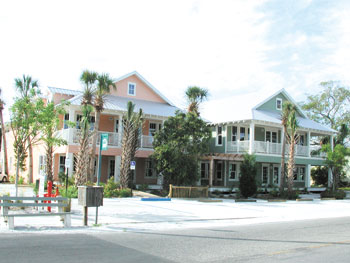New partners bring green to Pine

SUN PHOTO/PAT COPELAND
These two buildings are the first of
several
planned for the Pine Avenue Restoration Project.
ANNA MARIA – The newest partners in the Pine Avenue Restoration project hope to bring a fresh, green outlook to what they call the city’s "Main Street."
British couple Mike and Lizzie Thrasher, who own Beach Bums on Pine Avenue, have joined Ed Chiles, Ted LaRoche and Mike Coleman in the project, which features residential units built above retail stores.
The first building at 315 Pine Ave. is complete, and a residential unit at 317 Pine Ave. will be finished within a few days, Coleman said, adding that 14 lots are owned or under contract for purchase. Groundbreaking at 401 Pine Ave. is expected with the next 60 days.
"We remain very optimistic about Pine Avenue," said Coleman, who invited the Thrashers to invest in the project as 25 percent partners.
The couple had established a successful organic baby food business in the United Kingdom before relocating to Anna Maria, where they operate Pineapplefish rental homes in addition to the bike and kayak rental store, Beach Bums.
Their recent addition of solar panels to the store, which they expect to reduce their electric bill by half, is an example of the green thinking they bring to the Pine Avenue project, Lizzie Thrasher said.
"I’m an environmental businesswoman," she said. "I am intrigued by the approach. And Florida is such a fantastic place to use this energy."
Computer monitors are being installed to demonstrate to patrons how much energy the panels produce, she said, adding that the store itself promotes a non-polluting ethic, renting bicycles, surreys and kayaks and arranging kayak ecotours.
The Thrashers also use solar panels to heat swimming pools at their rental properties, and plan to add solar panels to a warehouse building they own on Pine Avenue, she said.
The Pine Avenue partners also have been thinking green, Thrasher said, using highly insulated walls to reduce air conditioning expense.
"Pine Avenue has a way that can be enhanced that will make it a better place for the people who live here and a more understandable place for visitors," she said, explaining that the project will improve some buildings on the street that have been neglected. "I’m interested in hearing what people have to say. It’s a chance for people to contribute to the city and make it a better place."
Her husband, a designer, "has a nice eye for the way things should be developed," Thrasher said. "With his design skills and my take on the environment, it’s about how much greener can we make it."


